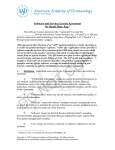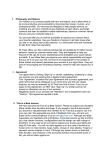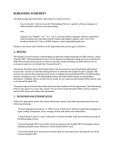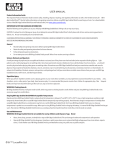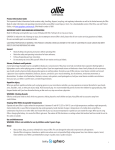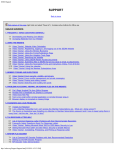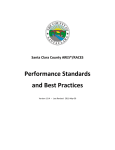Download AAD Sample Server Based EHR Licensing Agreement
Transcript
Software License Agreement By Daniel Shay, Esq. 1 This Software License Agreement (the “Agreement”) is made this _______________, 2010 by and between Vendor Systems, Inc., (“Vendor”), a California business corporation, and Dermatologic Associates of Springfield, LLC (“Practice”), a Pennsylvania limited liability company. 1. Definitions. Capitalized terms used in the Agreement shall have the following meanings: [This section establishes the meaning of the terms used in the agreement, even if they have other meanings elsewhere. A defined term should be capitalized wherever it appears in the agreement. All terms with special meaning should be included here. Some agreements define terms immediately after the first time you see them capitalized. Even so, be on the lookout for other capitalized terms in the document. Typically, these terms have a specific meaning. If capitalized terms aren’t defined, you should ask what they mean. Do not assume that you understand the precise meaning of an undefined, capitalized term.] A. “Confidential Information” means any and all proprietary information in any medium, including but not limited to the Documentation, systems, financial information, source code, data, pricing structure, training materials, customer lists, technology, formulas, trade secrets, copyrightable and patentable products, and the terms of this Agreement. B. “Documentation” means any and all manuals, user handbooks, guides, or other written information. C, “Hardware” means the Practice’s computer systems, including the server on which the Software is installed, the network infrastructure, and any peripheral devices used to access or otherwise make use of the Software. D. “Software” means the VendorSoft Practice Software Suite®, including VendorSoft Practice Management®, VendorSoft Electronic Medical Record®, and VendorSoft Prescription Management® modules. E. Software. 1 “User” means any Practice contractor or employee authorized to use the Member of Alice G. Gosfield and Associates, Philadelphia, Pa. Copyright © 2010 American Academy of Dermatology. All rights reserved. Reproduction or republication strictly prohibited without prior written permission. F. “Update” means any improvement or changes to the Software. Updates shall further include those changes to the software necessary to bring it into compliance with federal and state regulated changes which Practice identifies to Vendor in writing, or with which Vendor becomes familiar through other means. Updates do not include additional modules not included in the Statement of Work. [With respect to updates, make certain that the definition at least addresses changes in federal and state laws. Also, look for whether the definition distinguishes between what is required by law and what is merely an optional program. For example, the HITECH electronic health record incentives are not actually mandated by law — they are merely the conditions that must be met to obtain the payments. However, practices will want to obtain these payments, so it is important to ensure that the contract language will include updating the software to meet such requirements.] 2. License. Vendor hereby grants to Practice a non-exclusive, non-transferrable, non-assignable, limited license to install the Software on Practice’s Hardware, and to use the Software as specified herein. Practice shall be permitted to make one (1) backup copy of the Software. [This section describes in general terms the scope of the license. A “non-exclusive” license simply means that the Vendor may sell the same software to others, and that you do not have a unique copy. The “non-transferrable, non-assignable” language means that only the dermatology practice that purchases the license may use the software. In other words, you can’t take a copy home and install it on your home computer, nor can you lend a copy to someone else. Likewise, the software will not transfer to any entity that might purchase your practice’s assets.] 3. Practice Duties. A. Practice shall only permit authorized Users to use and access the software. Practice must submit a list of all such Users to Vendor, and must inform Vendor upon the departure of any Users, as well as the need to add any new Users. [Many licenses are sold on a per-user basis. Some licenses are sold on a per-doctor or per-professional basis, but permit an unlimited number of non-professional users, such as billing personnel, and office staff to use the software. When you remove or add users, you may need to notify the vendor. Usually, the vendor will sell you additional licenses for another user if needed.] B. Practice shall only use the Software on the designated Hardware. Notwithstanding the foregoing, Practice may use the Software on non-designated hardware if: (1) the designated Hardware is unusable due to malfunction, at which time Copyright © 2010 American Academy of Dermatology. All rights reserved. Reproduction or republication strictly prohibited without prior written permission. Practice may temporarily use non-designated hardware, or (2) the designated Hardware is replaced by Practice, at which time Practice must notify Vendor of such equipment change, and must remove Software from all prior Hardware. [Some licenses may be sold on a per-computer or per-device basis, while others are less restrictive. Even so, a vendor may require notification when you change your hardware, if only to provide proper support for the software. If you change to unapproved hardware, or hardware with which the software cannot communicate or function at full capacity, the vendor may want to know, so it can adjust its support accordingly.] C. Practice shall not remove any logos, emblems, trademarks, or other indications of Software’s origin without Vendor’s prior written approval. [EHRs that have trademarked logos or other designations of origin may restrict your ability to remove the logos. This is to protect the vendor’s trademarks.] D. During the term of this Agreement, Practice shall not reverse-engineer, create or attempt to create source programs based on the Software, nor modify the Software in any way without Vendor’s prior written permission. [Some vendors may permit modifications, but only when made under their guidance or with their approval. Vendors may let you customize the software to your specific needs, but may require that you do so only in accordance with their guidance, so that they can ensure continued software functionality.] E. Practice shall provide a proper environment and Hardware meeting at least the minimum specifications for the Software outlined in the Documentation. [Most software has minimum operating requirements. An EHR suite may have certain environmental specifications as well (for example, the room with the server must be maintained within a particular temperature range). Many licenses require that practices ensure the software will be used only in such an environment, to ensure that it operates properly.] 5. Support and Maintenance. A. Vendor shall provide technical support services to design, code, test, and deliver Updates to the Software necessary to correct any technical flaw resulting from any programming error attributable to Vendor. Practice shall pay Vendor ongoing monthly maintenance fees (“Maintenance Fees”) described in the attached Exhibit A. Copyright © 2010 American Academy of Dermatology. All rights reserved. Reproduction or republication strictly prohibited without prior written permission. B. Vendor shall provide technical support via telephone from 5 a.m. to 5 p.m. Pacific time, Monday through Friday, not including holidays. Vendor shall provide technical support via telephone from 5 a.m. to 5 p.m. during holidays at an additional charge described herein. [You should carefully review support clauses. Find out what qualifies as a “holiday”. Is it only Christmas, New Year’s Day, Thanksgiving, Independence Day, Memorial Day, and Labor Day? Or does the definition include days like Martin Luther King Jr. Day or Columbus Day? Even minor concerns might come into play here, such as the time zone from which support services are provided. Some vendors may also treat different support issues at different “levels,” and may specify different response times for specific levels. For example, a one-hour response time for “critical” problems, but a two-business-day response time for “routine” problems. It will be essential to find out what types of problems qualify for different levels of response.] C. Vendor shall offer the option for Practice to escrow the source code for the Software through Vendor’s Source Code Escrow service described in Exhibit B. [Some vendors offer source code escrow programs which let you purchase and maintain a copy of the source code for the software, should the vendor go bankrupt. Some source code escrow may be provided at no charge, or there might be a separate fee attached to the program. Source code escrow programs are important because the source code of the software is what makes the software actually operate on the computer. In essence, the source code is the software itself.] D. Practice shall maintain at all times a contact person who has been appropriately trained and certified by Vendor in the use of the Software and in diagnosing low-level problems with the Software (the “Designated Contact”). The Designated Contact shall be responsible for contacting and communicating with Vendor’s technical support services. If at any time Practice ceases to have a Designated Contact for a period longer than sixty (60) days, Practice’s maintenance fees shall be doubled. [Many licenses require that you designate a contact person to deal with the vendor’s tech support services. In some instances, failure to maintain a contact person can result in increased fees, or termination of support services altogether. This agreement allows some flexibility if you need to appoint a new contact person, which can be helpful for practices in the event that their contact person leaves. Another option is to establish more than one contact person.] E. As part of its efforts to improve the functionality of the Software, Vendor may continue to develop, modify, and update the Software. From time to time, Vendor may release new Updates for the Software which enhance stability, improve functionality, and address problems raised by Vendor’s customers. Practice may choose Copyright © 2010 American Academy of Dermatology. All rights reserved. Reproduction or republication strictly prohibited without prior written permission. not to apply such Updates, but Vendor shall be under no obligation to support any version of the Software which has not applied the most current Update. [Some licenses require that you keep your software up to date with patches, bug fixes, etc,. from the vendor, or you forfeit your right to support services. Other licenses include language similar to Section 5.E above, which do not explicitly state that you will lose all support services for failing to update the software, but rather gives the vendor the option to discontinue support when it sees fit. Understand, however, that legally speaking, the language above means that the vendor may choose to cut off support to non-updated software at any time. As a practical matter, however, vendors may continue support for non-updated software for several prior versions.] 6. Warranties and Disclaimer of Liability. A. Vendor hereby grants Practice a limited warranty for one (1) year following the date of installation (the “Warranty Term”) that the Software shall perform the functions described in the User Manual attached as Exhibit B when installed on Practice’s Hardware and when used in accordance with the User Manual. Vendor does not warrant that the Software will be error-free, nor that it will perform in accordance with Practice’s specific needs, nor that all errors can be corrected. This warranty shall be considered null and void in the event that Practice or any other unauthorized third party modifies the Software in any way in violation of any of Practice’s duties under Section 3 of this Agreement. [Most EHR licenses offer some kind of limited warranty, whereby the vendor promises that the software will operate in a specific way, and/or that the vendor has the right to enter into the agreement and license the software itself. These clauses, however, usually go hand in hand with the following disclaimers of liability.] B. NOTWITHSTANDING THE FOREGOING, VENDOR DOES NOT MAKE ANY EXPRESS OR IMPLIED WARRANTIES, CONDITIONS, OR REPRESENTATIONS TO PRACTICE OR ANY OTHER PARTY WITH RESPECT TO THE SOFTWARE, THE USER MANUAL, OR ANY SERVICES PROVIDED UNDER THIS AGREEMENT. ANY IMPLIED WARRANTY OR CONDITION OF MERCHANTABILITY, THE IMPLIED WARRANTY AGAINST INFRINGEMENT, AND/OR THE IMPLIED WARRANTY OR CONDITION OF FITNESS FOR A PARTICULAR PURPOSE ARE EXPRESELY EXCLUDED AND DISCLAIMED. C. PRACTICE ACKNOWLEDGES THAT IN NO EVENT SHALL VENDOR OR ANY OF ITS OFFICERS, DIRECTORS, SHAREHOLDERS, EMPLOYEES, AGENTS, OR REPRESENTATIVES BE LIABLE TO PRACTICE OR ANY THIRD-PARTY FOR ANY SPECIAL, INDIRECT, INCIDENTIAL, CONSEQUENTIAL, OR EXEMPLARY DAMAGES OR LOSS OF GOODWILL, Copyright © 2010 American Academy of Dermatology. All rights reserved. Reproduction or republication strictly prohibited without prior written permission. LOST PROFITS, OR OPPORTUNITIES IN ANY WAY RELATING TO THE SOFTWARE OR THE SERVICES PROVIDED UNDER THIS AGREEMENT, RESULTING FROM THE USE OR INABILITY TO USE THE SOFTWARE, OR THE PERFORMANCE OR NON-PERFORMANCE OF PRACTICE’S HARDWARE, THIRD-PARTY SOFTWARE, AND/OR SERVICES, WHETHER SUCH DAMAGES OR LIABILITY IS BASED ON THEORIES OF CONTRACT, TORT, STRICT LIABILITY, PRODUTS LIABILITY, OR ANY OTHER LEGAL THEORY. D. IF SOFTWARE IS USED IN CONNECTION WITH ANY DIAGNOSIS AND/OR TREATMENT BY PRACTICE, ITS EMPLOYEES, AGENTS, OR REPRESENTATIVES, PRACTICE AGREES TO ACCEPT ANY AND ALL RESPONSIBILITY IN CONNECTION WITH ANY INJURIES, DAMAGE AND/OR LOSS RELATING TO SUCH DIAGNOSIS AND/OR TREATMENT. E. IN NO EVENT SHALL VENDOR’S LIABILITY IN THE AGGREGATE FOR ANY DAMAGES TO PRACTICE OR ANY THIRD PARTY FOR ANY MATTER RELATING TO THIS AGREEMENT EXCEED THE SOFTWARE LICENSE FEES AND MAINTENANCE FEES PAID BY PRACTICE TO VENDOR, REGARDLESS OF THE FORM OF ACTION, WHETHER SUCH ACTION IS BASED ON THEORIES OF CONTRACT, TORT, STRICT LIABILITY, PRODUTS LIABILITY, OR ANY OTHER LEGAL THEORY. [All EHR license agreements include sections like these disclaimers. They are usually written in a combination of boldface and/or capital letters. These terms are necessary for the vendor to disclaim liability for a variety of potential problems. Given that patients can potentially be seriously harmed as a result of medical action relating to a software glitch, vendors attempt to limit their liability so as not to be stuck with the potentially very high damages that could result from such harm. While these clauses may seem like “mere boilerplate,” it is worth having a lawyer and your malpractice carrier review them. The lawyer may not be able to change the terms of the disclaimer, but they can at least tell you what is being disclaimed.] 7. Data Ownership and Intellectual Property. A. All business data obtained or created by Practice is the property of Practice, including patient clinical, financial, and insurance-related information. Vendor may, in the fulfillment of its duties under Section 5, access Practice’s data. At no time shall Vendor copy or otherwise use any data obtained or created by Practice. [Data ownership should be explicitly addressed in the license. While this is less of a concern for practices that install software on their own computers, the license should still specifically state that the practice owns its own data. If the vendor intends to use any of the data — even de-identified, aggregate data — the practice should at least Copyright © 2010 American Academy of Dermatology. All rights reserved. Reproduction or republication strictly prohibited without prior written permission. receive something in return whether as compensation, discounts, access to the aggregated data, or additional services or software modules.] B. Vendor shall maintain the exclusive ownership of all rights, title, and interest in and to the Software, Documentation, and other material provided by Vendor to Practice under this Agreement, and this Agreement does not provide Practice with title or ownership of the Software, Documentation, or other materials provided by Vendor to Practice hereunder. [The vendor will usually indicate that it retains ownership of the software, user manuals, or other documents and information it provides to the practice. This may be stated separately from the parties’ duties with respect to keeping each others’ information confidential (as is the case here), or may be consolidated into a single “Confidentiality” section.] 8. License Fees. A. As compensation for the use of the Software, Practice shall pay Vendor the license fees (“License Fees”) in accordance with the Statement of Work attached as Exhibit A. If Practice fails to pay any fee under this Agreement, Vendor may apply interest at a rate of 1.25 percent per month (15 percent per year). [Licenses may apply interest to late fees. Because the license agreements themselves are often form agreements, but the specific deal terms may differ from customer to customer, many licenses will also address the details of payment more fully in appendices, exhibits, or other separate documents. When this happens, make sure that the separate document is incorporated into the license agreement itself.] B. Practice’s failure to pay any License Fees or other expenses within ninety (90) days shall be considered a breach of this Agreement, and shall be treated as grounds for termination in accordance with Section 9 of this Agreement. 9. Termination. A. This Agreement may be terminated by either party without cause upon ninety (90) days prior written notice to the non-terminating party. B. This Agreement may be terminated immediately for cause upon the occurrence of any of the following events: (1) the non-terminating party’s voluntary or involuntary bankruptcy, dissolution, or insolvency; or, (2) the loss of any license, permit, certificate, or other similar credential by either party necessary to continue that party’s operation. Copyright © 2010 American Academy of Dermatology. All rights reserved. Reproduction or republication strictly prohibited without prior written permission. C. This Agreement may be terminated by either party for breach upon thirty (30) days prior written notice. If such breach has not been cured within the thirty- (30) day period, this Agreement shall terminate. D. Upon termination of this Agreement for any reason whatsoever, Practice shall return to Vendor all copies of Software, the Documentation, and any other materials provided by Vendor to Practice during the course of this Agreement. Practice shall further delete all copies of the Software from its Hardware, and shall provide Vendor with a certificate of destruction indicating that it has done so. E. Termination of Practice’s support services under Section 5 shall not constitute a termination of this Agreement. [The termination section is one of the most important sections of the license agreement. Pay close attention to what happens after termination. Usually, the practice will be required to return the software, user manuals, or other documentation. When the software has been installed on practice hardware, the vendor may require proof that the software has actually been deleted from the practice’s computers. Another critical issue to consider is post-termination data conversion. If the software stores all the data or even some data elements in a vendor’s proprietary format, the practice will need to have that data converted to a neutral format following termination. Some vendors do this for free, others might require compensation. The license agreement should specify how this will be handled. Finally, do not allow your data to be held hostage — either because the vendor retains a copy of it, or because they refuse to convert the data into a neutral format, thereby rendering it useless without the software to interpret it.] 10. HIPAA. The parties shall comply with the requirements of the Health Insurance Portability and Accountability Act of 1996 (“HIPAA”) and its regulations, and with the HIPAA Business Associate Exhibit, attached as Exhibit D. [If the vendor will have any access to your patients’ information, you will need a clause like this and a business associate agreement — or exhibit — where the vendor becomes your business associate. Do not necessarily accept their business associate document, either. Because you are the covered entity for HIPAA purposes, you bear most of the responsibility and potential liability. Don’t be afraid to suggest your own business associate agreement, although be prepared for larger vendors to reject it. . Remember that the new HITECH law made several modifications to HIPAA with regard to EHRs. Privacy concerns including breach notification requirements and securing electronic data are important components to your EHR. For more information please see www.aad.org/pm/compliance/hipaa.] 11. Indemnification. Vendor shall, at its own expense, indemnify Practice for any action brought against Practice based on any claim of copyright, trademark, or patent Copyright © 2010 American Academy of Dermatology. All rights reserved. Reproduction or republication strictly prohibited without prior written permission. infringement, or license, trade secret, or other proprietary right having been violated by the Software or any Update. Practice must notify Vendor within writing of any such claims, and may not settle any such claims without Vendor’s prior written approval. Vendor shall have the right to appoint attorneys and conduct a defense of any such action as it sees fit, but shall do so in coordination with Practice. [Indemnification means that if you are sued for the vendor’s failure (with respect to whatever is specifically indemnified), the vendor will pay for the litigation of the lawsuit and damages which arise from it. Not all licenses include indemnification language like this. However, in some instances, vendors will offer to indemnify a practice if the practice is sued for copyright infringement or other similar actions based on a claim that the software itself violates another party’s copyrights.] 12. Confidentiality. A. The parties recognize that they shall, during the term of this Agreement, have access to certain non-public information of each other in oral, written, graphical, or machine-readable form, including but not limited to: patient medical information; trade secrets; research; product plans; products; inventions; processes; designs; algorithms; source code; programs; business plans; financial data; agreements with third parties; marketing plans; copyrightable materials; patentable materials; and the terms of this Agreement (collectively, “Confidential Information”). B. Under no circumstances shall either party disclose or make public any Confidential Information, and neither party shall use such Confidential Information except in the performance of its duties under this Agreement. The parties may disclose Confidential Information to their respective directors, officers, employees, agents, consultants, attorneys, and accountants, provided that they must require each such entity to maintain the Confidential Information as confidential at all times. Notwithstanding the foregoing, either party may disclose Confidential Information to respond to a subpoena or court order, but the disclosing party shall inform the other party to permit the other party to obtain a protective order. [Confidentiality provisions are common in license agreements. They protect both parties’ confidential information. Given that each party will have access to sensitive information belonging to the other party, it is a good idea to include a confidentiality provision. Be sure the confidentiality provision includes language that lets the parties disclose data under specific circumstances so that they can respond to a subpoena or court order.] 13. Miscellaneous. Copyright © 2010 American Academy of Dermatology. All rights reserved. Reproduction or republication strictly prohibited without prior written permission. A. Assignment and Sublicensing. Practice may not assign its rights or duties under this Agreement, nor sublicense the Software to any other party without Vendor’s prior written permission. Vendor may not assign its rights or duties under this Agreement without Practice’s prior written permission. [Assignment clauses may seem like “mere boilerplate,” but they can have significant implications in an EHR license. Make certain that the vendor either cannot assign its duties at all, or that it must obtain your permission before doing so. If you purchase software with the expectation that you will also be getting the vendor’s support services, and they subsequently assign those duties to another entity, you will want to be able to terminate the agreement. Without appropriate language in the assignment clause, this may be more difficult. If the vendor can assign, for example if it is sold to another company, you may be dealing with an entirely different company.] B. Independent Contractors. This Agreement shall not be construed as to create any employment relationship, partnership, or joint venture between the parties, or to authorize the parties to enter into binding agreements on behalf of each other. The parties shall, at all times during and following termination of this Agreement, remain independent contractors of each other. C. Waiver. A failure by either party to object to a breach of any obligation or duty of the other party under this Agreement shall not constitute waiver of such breach in the future. [Waiver clauses permit you to enforce the terms of the agreement, even if you failed to enforce them in the past. Without a waiver clause like this, for example, a practice which does not attempt to terminate the agreement for the vendor’s failure to respond within a specified timeframe to a technical support issue will waive the right to terminate in the future for a similar failure.] D. Choice of Law and Venue. This Agreement shall be construed under the laws of the State of California, without regard to conflicts of law principles, and any disputes relating to this Agreement shall be brought in the applicable jurisdiction in the State of California. Practice hereby submits to the jurisdiction and venue of such court. [If a practice is located in one state, and the vendor is located in a different state, the state law that controls the contract is very important. Contracts may be enforced differently in different states. Likewise, practices often find themselves submitting to jurisdiction in the vendor’s home state, which may mean that litigating a dispute will require travel to that state.] Copyright © 2010 American Academy of Dermatology. All rights reserved. Reproduction or republication strictly prohibited without prior written permission. E. Notices. Notices shall be sent, in writing, via nationally recognized overnight carrier or by certified, return receipt requested, postage prepaid U.S. mail to the addresses specified in Exhibit A. Notice shall be effective upon delivery. [Generally speaking, notice can be done via overnight carrier such as FedEx or UPS, or certified return receipt mail. In each case, the method of delivery includes some indication of when delivery was made, for purposes of the effective date of notice. Notice by fax, or “deemed” notice three days after deposit in the mail are not acceptable because they permit notice to be claimed to have been received when you may not have received the notice.] F. Incorporation. This Agreement and any attachments, exhibits, and appendices referred to herein, are hereby incorporated by reference, and represent the complete and exclusive statement of the agreement between the parties, which supersedes all proposals, marketing literature, or other written or verbal statements between the parties. G. Severability. If at any time, a court of competent jurisdiction determines that any provision of this Agreement is invalid, such provision shall be ineffective only to the extent of such invalidity, and all other remaining provisions shall be valid and enforceable to the fullest extent permitted by law. H. Force Majeure. Neither party shall be liable for failure to perform any of its respective obligations hereunder if such party’s failure to do so is caused by an event outside its reasonable control, including but not limited to acts of God, war, terrorism, or natural disasters. [Force majeure clauses are common in commercial space leases, but might also be relevant to licenses where the practice is also receiving services from the vendor. If, for example, the vendor is located in California, but is unable to provide services due to rolling blackouts, wildfires, mudslides, or earthquakes, the vendor will not want the practice to be able to terminate. Likewise, if an East Coast practice is unable to send a monthly maintenance fee check to the vendor due to record blizzards, the practice will not want the vendor to consider that they have breached the contract.] IN WITNESS WHEREOF, authorized representatives of the parties have signed this Agreement. [VENDOR] [PRACTICE] By: ___________________ By: ____________________ Copyright © 2010 American Academy of Dermatology. All rights reserved. Reproduction or republication strictly prohibited without prior written permission. [When it is finally time to sign, be sure to sign the document, retain a copy for your files, and forward a fully executed copy to your attorney for his or her files. If there are disputes in the future, it will be essential to determine which version of the agreement was in effect at the time of signature. Also, before signing, make sure that all blanks in the agreement have been filled in, including effective dates, addresses for notice, dollar amounts, timeframes for termination, notice, or other issues, etc.] Copyright © 2010 American Academy of Dermatology. All rights reserved. Reproduction or republication strictly prohibited without prior written permission. Exhibit A Statement of Work 1. Products. Product VendorSoft Practice Management® VendorSoft Electronic Medical Record® VendorSoft Prescription Management® License Term Perpetual Perpetual Perpetual Number of Licenses Five user licenses Five user licenses Five user licenses License Fee Maintenance Fee Deposit Delivery Date $XXXXX $XXX per month $XXXX XX/XX/XXXX $XXXXX $XXX per month $XXXX XX/XX/XXXX $XXXXX $XXX per month $XXXX XX/XX/XXXX [This table outlines the scope of the license. The software is priced on a per-user basis, and the practice is buying five user licenses. The license does not limit the number of terminals or computers on which the software may be installed. This will differ from license to license. Some licenses may limit both the number of users and the number of terminals. Other more expensive licenses may be what are known as “site” licenses, which allow any number of users to use software on any number of terminals, but only within the defined geographic space of the “site.” License will also often require a deposit.] 2. Delivery and Installation. The Software and any Hardware purchased from Vendor by Practice shall be shipped to Practice’s location by common carrier. Risk of loss for the Software and Hardware shall remain with Vendor until delivery. Following delivery, Vendor shall install the Software on Practice’s Hardware, and shall customize the Software as best as possible to accommodate Practice’s workflow. [Some Statements of Work are more elaborate than others, and some license agreements do not even include a Statement of Work or any discussion of how the vendor will address installing the software and getting it running for the practice. In this case, the Statement of Work is relatively uncomplicated and does not go into the level of detail that can be found in other Statements of Work. This is not necessarily a problem, but either the Statement of Work or the main agreement should clearly lay out things like the delivery timeframes, whether training will be offered, the methods of Copyright © 2010 American Academy of Dermatology. All rights reserved. Reproduction or republication strictly prohibited without prior written permission. delivery, and whether failure to install and have the software up and running by a specified date will constitute a breach — and such a failure should be considered a breach. If the license does not even address these issues, you should raise the matter with the vendor, and try to have language added to the agreement that discusses delivery, installation, and implementation. If some separate documentation, such as a general implementation plan, controls how the process will work, it should be incorporated into the license.] 3. Training. Vendor shall conduct a training program in the use of the Software for Practice’s physicians, clinical personnel, and non-clinical personnel. Training shall be conducted in three phases, for one day each, prior to the date when the Software shall be ready for use by Practice (the “Go-Live Date”). The schedule for training shall be: - Phase 1: Non-Clinical Personnel. Conducted on XX/XX/XXXX. - Phase 2: Clinical Personnel. Conducted on XX/XX/XXXX. - Phase 3: Physicians. Conducted on XX/XX/XXXX. If additional training sessions are needed, they shall be available for an additional fee of $XXX per session. [As part of implementing/installing the software, many vendors will provide training — where additional training might cost extra, as well as staged implementation. Staged implementation may include other steps, depending on the complexity of installing the software and setting it up for use by the practice. This implementation is not particularly complex. Training may sometimes be included in the price for the license itself, or may have additional costs associated with it, such as payment for travel time, lodging, and expenses for training staff from the vendor.] 4. Deadlines. Vendor’s failure to implement the Software by the Go-Live date shall constitute grounds for termination of this Agreement. Notwithstanding the foregoing, Vendor’s failure due to Practice’s failure to prepare its facilities, personnel, and/or Hardware for installation shall not constitute grounds for termination, and Vendor’s failure in any event shall not be liable for any damages or penalty for any delay in delivery, installation, or implementation, or if the Software has not been implemented by the Go-Live date. [The vendor will usually disclaim any liability for failing to deliver the software on time. This is because they would incur significant damages, such as your practice’s lost profits, if they failed to do so. However, failure to deliver on time can and should still be grounds for termination if you choose to exercise that option.] Copyright © 2010 American Academy of Dermatology. All rights reserved. Reproduction or republication strictly prohibited without prior written permission. Exhibit B User Manual See Attached. [User manuals vary widely in terms of what they describe, and whether they place requirements on practices. This model license does not include a model of a user manual, because of the degree of variation that can be found in such manuals. Practices should carefully review their user manuals prior to signing the license, to make sure that they can comply with any requirements.] Copyright © 2010 American Academy of Dermatology. All rights reserved. Reproduction or republication strictly prohibited without prior written permission. Exhibit C: HIPAA Business Associate Exhibit [Depending on the services the vendor provides the practice, most licenses will require the vendor to be the practice’s business associate (“BA”). This model agreement does not include a sample business associate exhibit, simply because such documents can, like the user manual, vary from vendor to vendor. Most vendors also have a standard business associate document, simply to avoid having to sign and keep track of multiple esoteric business associate documents from each practice. The vendor might be willing to make minor adjustments — for example, to update an old form to take into account new HIPAA requirements under the HITECH Act — they often will not make sweeping changes.] Copyright © 2010 American Academy of Dermatology. All rights reserved. Reproduction or republication strictly prohibited without prior written permission.
















